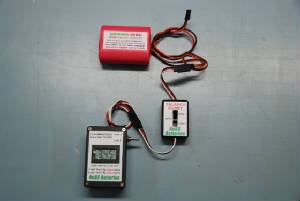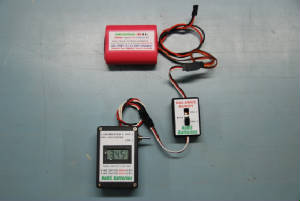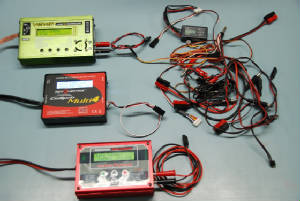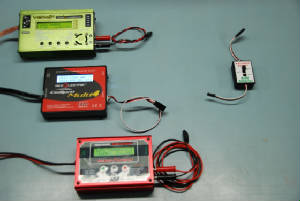|
|
 |
|
Separate
But Equal - The
Politically Incorrect Solution to A123 Rx Pack Charging & Cycling
|
|
|
 |
If your like most folks, getting a ‘grip’
on A123 balance charge support with the wide array of A123 capable chargers equipped with their goofy little balance plugs,
balancer boards, multiple cable connections and complicated programming presets can be intimidating if not outright annoying.
We have a solution. -
Here’s the issue.. the multi chemistry
chargers with A123 capabilities need access to the individual cells in the pack to conduct a balanced charge routine. Every
one of these chargers in balance mode needs a three wire connection to the pack via a ‘balance tap’. None of them
use a system standard ‘Univ’ FJ/JR/Hitec servo type connector. All of them use some strange little white molex
type plug setup for balancing, none of them share commonality with their competitors plugs.. worse, none of them provide an
adapter cable that will connect to a RC standard servo plug for balancing unless you fork over another 10 bucks. With most
chargers, even when you purchase a suitable adapter to get at the Univ balance plug provided on most R/C A123 Rx packs you
STILL need to make two separate connections to the pack to ‘balance charge’, making it necessary to either open
the plane up to get at the balance plug or install a separate charge port to get at it AND the switch chargeport at the same
time. -
FMA took a big stride in eliminating the
‘two connections to the pack’ route with their Cellpro and Multi-4 chargers, but the very slow balancing charge
rate (common on all balancing chargers, not just FMA’s) can get in the way of getting more flying in when balancing
is necessary at the field. And, you’ve still got to fork over the 10 bucks for the adapter cable to balance charge in
the plane via the switch chargeport. -
Over the course of
the last 3 years, we’ve learned unequivocally that balanced or ‘equalized’ A123 packs are crucial to the
security of your aircrafts power system. Bypassing the slower ‘balance’ or ‘accurate’ charge routines
results in the cells getting un-equal in state of charge pretty rapidly and that can lead to a discharged cell in the pack
while the other cell still has better than half it’s capacity remaining. Leave a switch on, connect the Univ charge
cord adapter into the switch port ‘upside down’, ignore the balance charge routines in favor of the faster ‘unbalanced’
charge mode will eventually result in grief and aggravation at the least.. tragedy at the worst. -
After many long hours of discussion, trials, evaluation and testing we’ve
developed a simple inexpensive approach to solving the problem. Most of us are quite familiar with the concept of Parallel
Pack systems.. we’ve used them for decades to provide redundancy, provide superior power handling and increase flight
times. Charging and support of two packs is simple.. you charge one pack, then the other and go fly. You
check each pack and charge each pack separately. Pretty basic, tuff to get in trouble as long as you check and charge each
pack separately. -
Enter the solution to the A123 Conundrum.
Treat your 2 cell A123 pack as two separate ‘packs’.. check,
charge or cycle each cell separately. -
Seems easy enough.. yet none… not
ONE A123 capable charger can separate the cells in the pack for voltage checks, load checks or charging the cells independently.
On the other hand, just about every single A123 capable charger can perform an unbalanced charge on your battery pack. You
tell the charger you want to charge an A123 pack, you tell the charger how many cells are in the pack, you select a charge
rate and you hit the ‘start’ button. The issue remains.. if the charger can’t separate
the cells for individual checks and charging and takes hours to ‘re-equalize’ or balance a severely out of balance
pack, how can you check and charge each cell independently? You’ve either got to build up a couple
of specialized adapters out of short aileron extensions by moving around the pin contacts in the plugs or you can grab up
our A123 Balance Buddy, plug it into the packs Univ celltap or 3 wire Combo power feed, plug the charger into the Balance
Buddy and ‘Wallah’! You’ve got access to each cell independently or
both cells together! To swipe a phrase from a beer commercial… “Brilliant!” -
So, how’d we do it? Not particularly difficult.. we started with a 4 pole
triple throw switch, designed a circuit board for it, added a standard 3 wire aileron extension for common connection with
any Univ cell tap equipped A123 rx pack and put it all in a small, easy to tote around enclosure. This
handy little device will turn any A123 capable charger into an equalizing / balancing charger without any additional funky
cabling or modified aileron extensions with the contacts shifted around. Just use the two wire FJ/JR universal factory provided
output cord that came with most of the chargers you already have for your Nicad or NiMH packs, plug it into your Balance buddy
and connect to the univ balance tap on your A123 pack. Done. If you have an FMA charger with a Univ charge adapter cable,
you’ll still have access to your chargers balance features, fuel gauging, etc.
|
 |
|
Using the Balance Buddy, ‘Standard’ two lead equipped
A123 pack
|
|
In the pic above, (click the pics for full size) we’re
showing the connection routine for the most common A123 pack charging connection; the three wire cell tap would go to a separate
balance charge port. You just plug the balance buddy into the balance charge port and the charger or load tester into the
Balance Buddy. Select which cell you wish to charge or check and proceed to either charging or checking the cell selected.
(yep, it’s that simple!)
|
 |
|
Using the Balance Buddy with a single ‘Combination Three
Wire Power Feed’ equipped A123 pack.
|
|
This is even
easier… in the pic above, we’ve got a Combo three wire lead on the pack. No separate power feed is required,
the charging connection would be done via a Modified ElectroDynamics HD Chargeport switch on the aircraft. We developed
this simple connection system to take advantage of FMA’s single cable chargers, eliminating the need (if you had an
FMA Charger) for a separate chargeport on the aircraft to do balance charging in the plane. When we designed the Balance Buddy
we decided to accommodate the FMA chargers requirement for ‘throughput’ to the individual cells for fuel gauging
and balancing using the chargers balance routine. The only issue we had with the FMA charger since it’s introduction
was it’s very slow charge rate when in balancing mode when the cells were significantly out of balance. (this issue
is not an FMA exclusive.. all balancing chargers are very slow in balance mode) The balance Buddy does the trick.. you loose
none of the advantages of the FMA’s single lead connection and gain the ability to quickly access and charge each cell
independently in the event of a severe cell imbalance in the pack... and we can now use just about anybody's A123 capable
charger to get an equalized pack charge without two pack connectors or two connections to the charger. (ThunderPower 610 shown
above)
|
 |
|
Using the Balance Buddy with an ESV for Voltage and Load checks
| Volt Check, Total Pack Voltage ("Both") |

|
| click pic for full size! |
|
| Volt Check, Cell #1 |

|
| click pic for full size! |
|
| Volt Check, Cell #2 |

|
| click pic for full size! |
|
Here’s where we get some more versatility.. since
we’ve already learned that being able to observe individual cell voltages is the key to determining relative charge
level of the cells, and that this info is crucial to the ‘fly or no-fly’ decision; so how to do it without
starting a charge routine with a balancing charger fully connected with all the required cables? Simple… just plug
the Balance Buddy into the balance chargeport (‘Standard’ setup) or the switch chargeport (Combo Feed setup) and
do your checks using the Balance Buddy switch for cell1, cell2 and ‘both’ selections. -
Discharging with a Balance Buddy - Oh, yeah; it does that too! One of the annoyances I encountered
with the FMA Multi-4 was the lack of a discharger incorporated into it when it was finally released. In the A123 Care and Feeding Guide I discuss how to use a standard programmable Nicad/NiMH charger/cycler to conduct a discharge capacity check using
that chargers programmable Nicad discharge function. We're also running into situations where 'smart' multi-chemistry charger
cyclers don't actually use individual cell voltages to trigger a shutdown when cycling, leading to overdischarge of one cell
in the pack. Using your cycler with a Balance Buddy will now allow you to discharge for capacity checks each cell in
your Rx pack separately! Neat, enh? Note: Individual cell discharge voltage
cutoff should be set at 2v, load set at 1 amp. -
The Best Part about The Balance Buddy (besides it’s $30
price) |
| Go From This... |

|
| the usual balance cables and board rats nest |
|
| To Just This!! |

|
| Pack Equalization.. without cable representation! |
|
Up till now, if you had anything other than an FMA single cable output charger you’d need to install a separate
chargeport on your plane to get your charger to perform a balance charge. Then you’d need to make or purchase an adapter
cable that connected between your chargers balance board to the separate chargeport on the plane. Then you’d still need
your OEM type Univ (Fj/JR/Hitec) banana plug connection from the charger to the switch chargeport to perform a balance charge
routine. Now, with any A123 capable charger and a Balance Buddy you can ‘Balance’ or ‘Equalize’ and
Check the individual cell voltages with a standard ESV on your 2 cell A123 Rx pack via a modified Chargeport
without that pesky balance charge adapter cable!! How to take advantage of this? Easy.. order your pack with NO balance connector
and WITH a 20g 3 Wire Combination Power Feed. You can use any chargeport equipped HD switch, just remove the white or yellow
‘third wire’ from the plug on your switch that goes to the Rx. See the notes on our A123 Setup Guide on how to do this..
Technical Details,
Charger Setup, Things to look out for.. - - ALWAYS verify your
charger settings for cell count before starting a charge with a Balance Buddy in the circuit. If single cell charging, check and VERIFY that the charger is in ‘1S’ mode. When charging in ‘both’
mode, the charger should be in 2S mode. Accidentally charging a single cell (switch selector at cell 1 or cell 2) with the
charger in 2S mode will kill that cell outright! One of the biggest historical ‘killers’ of 2 cell A123 Rx packs
has been the tendency of ‘smart’ chargers to incorrectly interpret the voltage sample taken from a near fully
charged 2 cell pack and falsely concluding that the pack is a discharged three cell pack. PAY ATTENTION.. when equalizing
a pack you are the charger’s ‘brain’, make sure the charger’s
cell count assumption displayed on it’s screen matches with your cell selection on the Balance Buddy BEFORE you start
the charge.
- Your charge rate with a Balance Buddy in line is limited to 3 amps… that’s the maximum
sustained continuous current rate that standard OEM connectors can tolerate.
- Do not change the position of the cell selector switch while the
charger or your load tester is ‘passing current’. It’s ok to switch while the charger
or load tester are connected, but NOT while applying a load, discharging or actually engaged in charging.
- Don’t leave your Balance Buddy out
in the rain, drop it into your catbox or trample it into the mud.. the slide switch is susceptible to dirt, small debris and
moisture. Keep it clean!
- When
using your Balance Buddy to enable single cell discharging on an A123 Rx pack, set the low voltage cutoff value at 2v. (4v
if discharging as a 2 cell pack) Discharge current must be limited to 3 amps maximum (most charger/cyclers only discharge
at only 1 amp max anyway).
Q: Can Balance Buddy be
used with Batteries other than A123? A: Nope.. at least, that's not the intent; I came up with Balance Buddy to solve a problem extant with 2 cell A123
packs.... On 2 cell battery pack systems that are wired with a 'tap' between the cells Balance Buddy will allow individual
access to each of those 2 cells. Since nicad & nimh packs used in the hobby have 4 or more cells and are not wired with
'taps' between the cells it would be useless. Same for Lipo or Lipoly packs with more than two cells, even if they were wired
with taps Balance Buddy is limited by it's switch and cabling to 2 cell packs equipped with at least one three wire Univ
(JR servo type) connector. How
to get one... You can add it to your cart from here or our
A123 Packs page. We know you are going to love our 'Politically Incorrect' solution to A123 Charge Equality!
NoBS Batteries A123 'Balance Buddy' for 2
cell Rx & Ignition Packs $29.95 |
|
|
|
WARRANTY: All new NoBS Balance Buddy
Modules are guaranteed for 90 days from date of purchase to be free of material workmanship or assembly faults. All modules
are checked and tested prior to packaging, therefore a NO DOA free replacement guarantee is offered. However, since I cannot
control your knowledge of correct implementation of proper charging routines, the age or quality or proper installation of
switches, connectors or batteries in your R/C applications, your maintenance procedures or your use of or knowledge of correct
battery system charging equipment or your diagnostic skills and/or your interpretations of data displayed for safe operation
of the aircraft and as a result, your decision to fly; no warranty, expressed or implied with respect to suitability for your flying application is available. By
acceptance of this product and placing it into service the purchaser and user agrees to accept all responsibility and any
liabilities for all risks posed by use of the product and to not hold the manufacturer, distributors or retailers responsible
for any subsequent accident, injury or death to persons or damage to property. - NOTE: FMA, Thunder Power, ElectroDynamics, Multi-4, CellPro are
copyrighted trademarks. The fair use of a copyrighted work for purposes such as criticism, comment, comparison, news reporting,
teaching (including multiple copies for classroom use), scholarship, or research, is not an infringement of copyright. TITLE 17 > CHAPTER 1 > Sec. 107. US Code. Effective 10/10/2010 ‘Balance Buddy’ is a copyrighted
Trademark, US Patent Pending. All Rights to this device and intended applications, foreign or domestic are reserved.
Hangtimes Hobbies NoBS Batteries
|
|
|
 |

